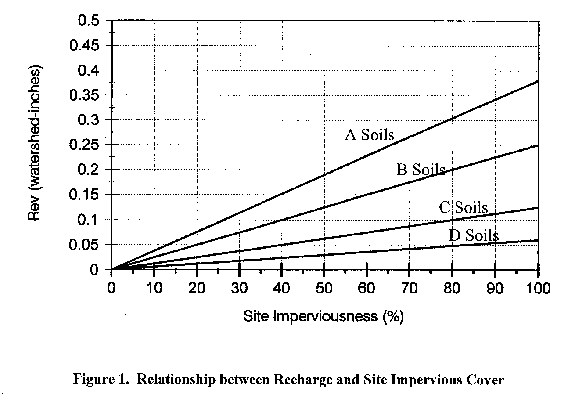As the land surface is paved, and converted into relatively impermeable urban soils, rainfall is unable to percolate into the ground, reducing the amount of groundwater recharge. This change alters the natural hydrology of stream and wetland systems, reducing the dry weather flow of stream systems. This change harms the habitat of many aquatic organisms. The recharge requirement attempts to reverse this impact by requiring that a specific volume of runoff be recharged into the groundwater, based on site characteristics.
In this section we describe basic options for groundwater recharge, and presents default criteria that will be used in the remainder of the Manual Builder.
Currently only two states, Massachusetts and Maryland,� require groundwater recharge. In both states the required recharge volume is based on the hydrologic soil groups (HSGs) at the site, and the amount of impervious cover created by the development.� A state or community could alternatively base this requirement on other soil and site properties, such as the actual soil permeability, or type of vegetation.
Provide recharge at a site, such that:
Rev = (S)(Rv)(A)
Where: �����������
�����������
S =� The Recharge
Factor (Fraction of the WQv to be infiltrated for a specific soil type; Table
1)
�����������
RV = Runoff Coefficient (Determined based on site impervious
cover)
�����������
A = Site Area (acres)
![]() The
recharge volume could alternatively be expressed as a fraction of the water
quality volume, rather than in watershed inches.
The
recharge volume could alternatively be expressed as a fraction of the water
quality volume, rather than in watershed inches.
Table 1.� Values of the Recharge Factor (S) |
|
|
Hydrologic Soil Group (HSG) |
Recharge Factor (S)(Inches) |
|
A |
0.38 |
|
B |
0.25 |
|
C |
0.13 |
|
D |
0.06 |
![]() The
values presented in this table are those used in Maryland. A different set of
recharge requirements could be used in a specific locality.
The
values presented in this table are those used in Maryland. A different set of
recharge requirements could be used in a specific locality.
![]() A
community may base the recharge requirement on factors other than or in addition
to the soil group, such as the native vegetation, site slopes, and other factors
that influence groundwater recharge.
A
community may base the recharge requirement on factors other than or in addition
to the soil group, such as the native vegetation, site slopes, and other factors
that influence groundwater recharge.
The relationship between the Rev and WQv is shown in Figure 1.

The recharge volume is considered part of the total water quality volume (WQv ) that must be provided at a site and can be achieved either by a structural practice (infiltration, bioretention), a nonstructural practice (filtration of sheet flow), or a combination of both.
![]() Few
practices can effectively meet recharge requirements.� Often, a community may
need to incorporate stormwater credits,
such as stream buffers and rooftop disconnection in order to meet the requirement.
Few
practices can effectively meet recharge requirements.� Often, a community may
need to incorporate stormwater credits,
such as stream buffers and rooftop disconnection in order to meet the requirement.
Basis of Design for Recharge
Specific limitations and guidance on the application of the recharge requirement include:
1)�������� If more than one hydrologic soil group (HSG) is present at a site, a composite recharge volume shall be computed based on the proportion of total site area within each HSG.� Any recharge provided at the site should be directed to the most permeable HSG.
2) The recharge criteria does not apply to any portion of a site designated as a stormwater hotspot. In addition, the appropriate local review authority may relax or eliminate the recharge requirement if the site is situated on unsuitable soils (e.g., marine clays), karst or is in a redevelopment area with contaminated soils.
![]() Other
caveats may apply to the use of groundwater recharge on a site.� For example,
a community with chloride concerns in groundwater may disallow infiltration
from roads or parking lots where road salt is used.
Other
caveats may apply to the use of groundwater recharge on a site.� For example,
a community with chloride concerns in groundwater may disallow infiltration
from roads or parking lots where road salt is used.